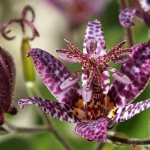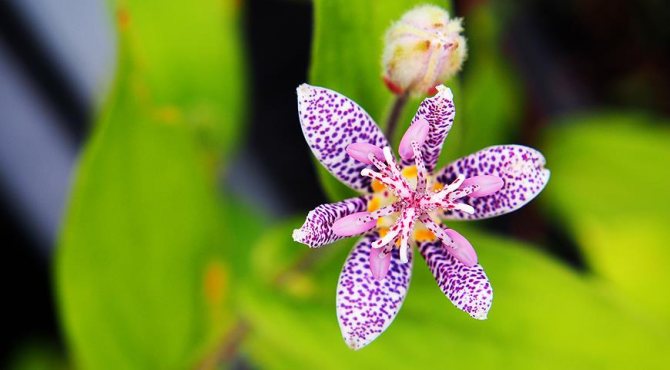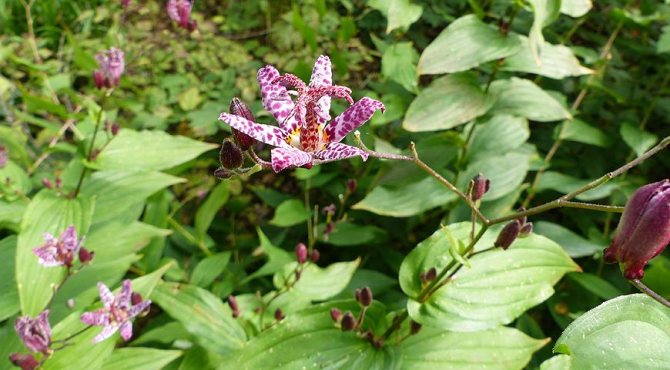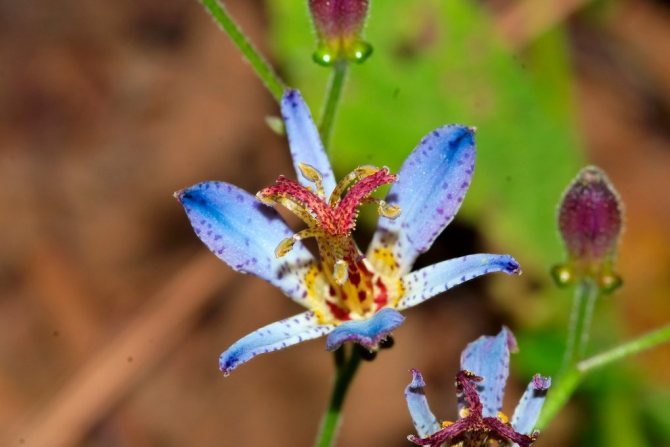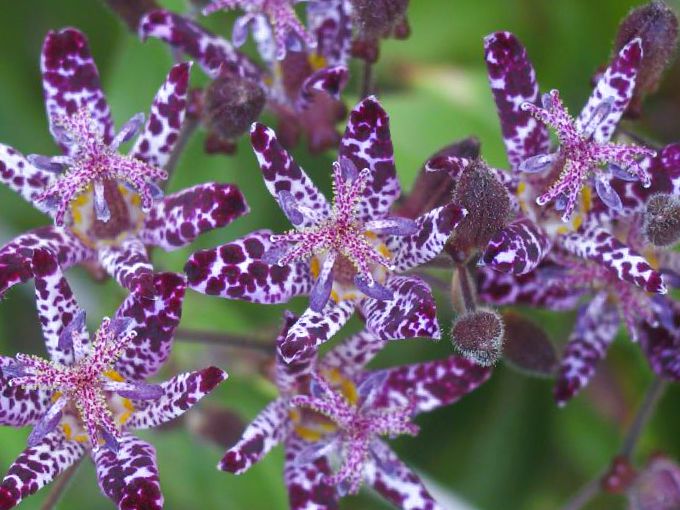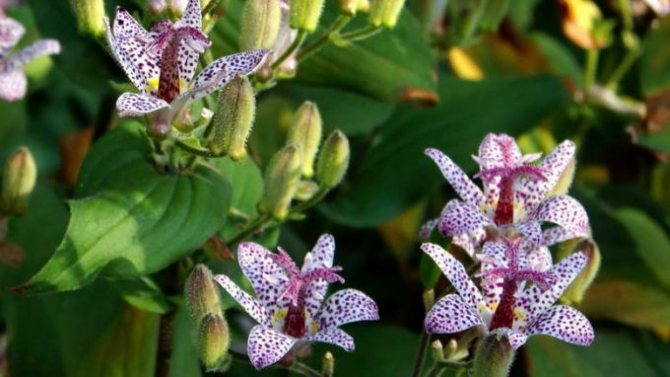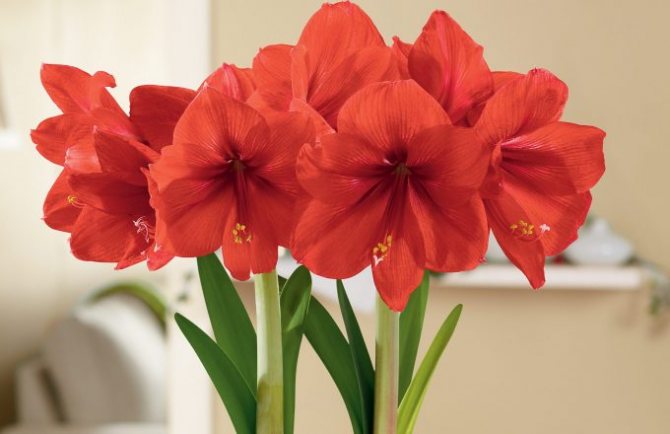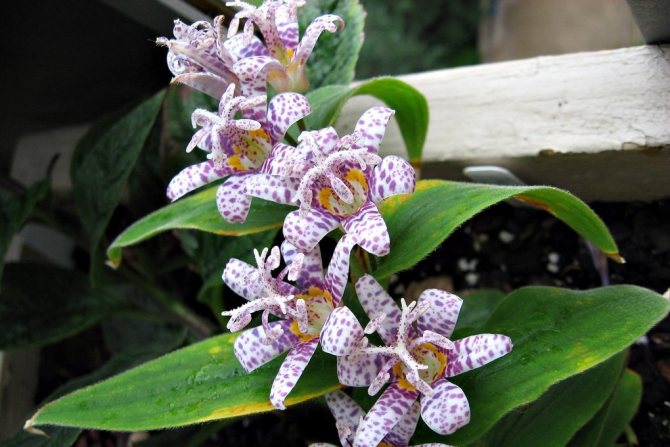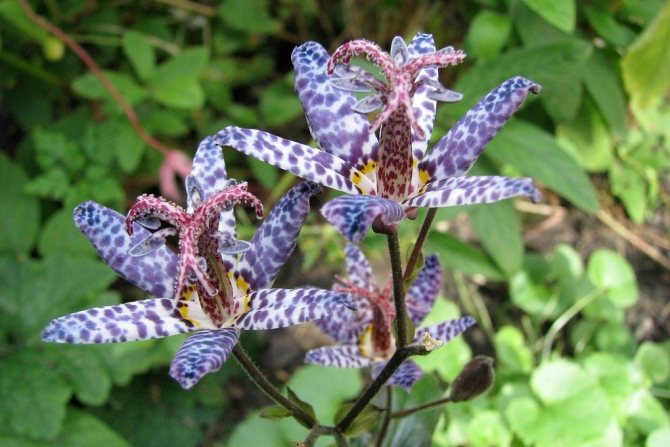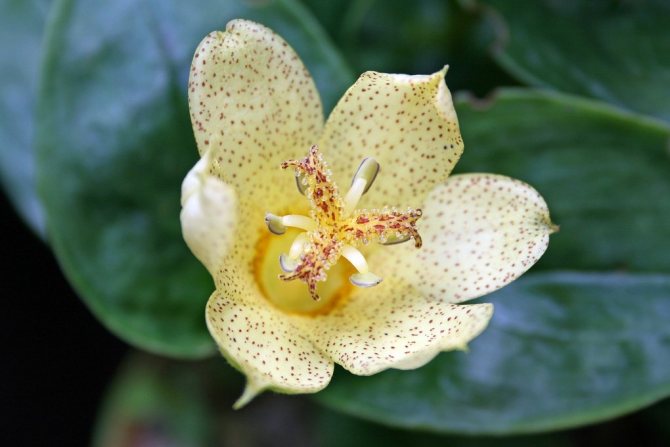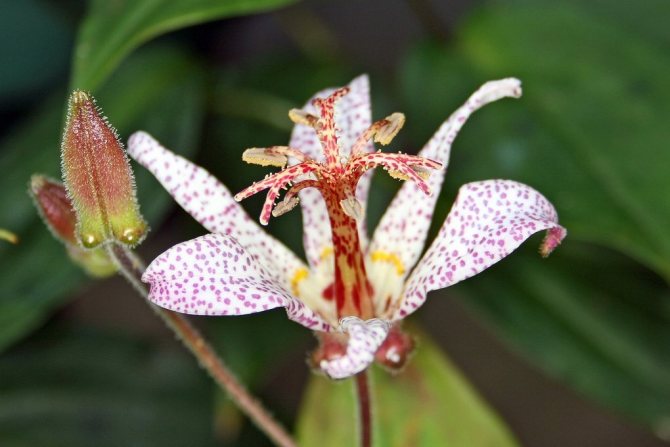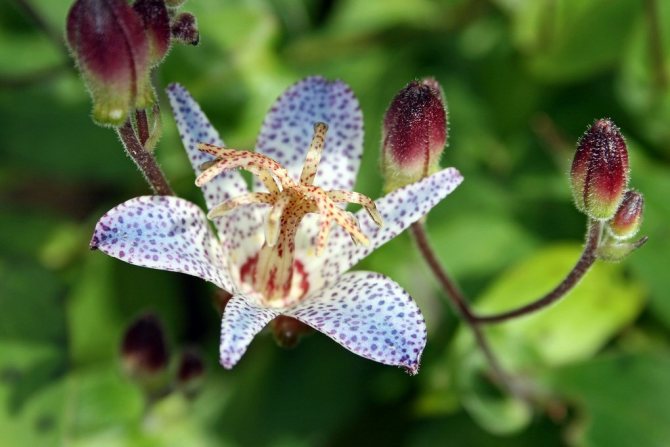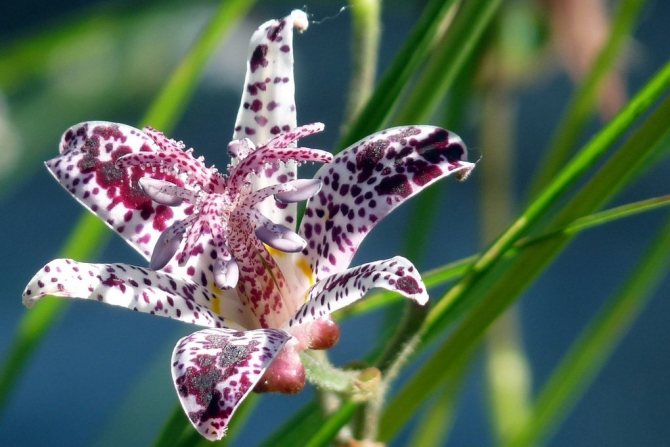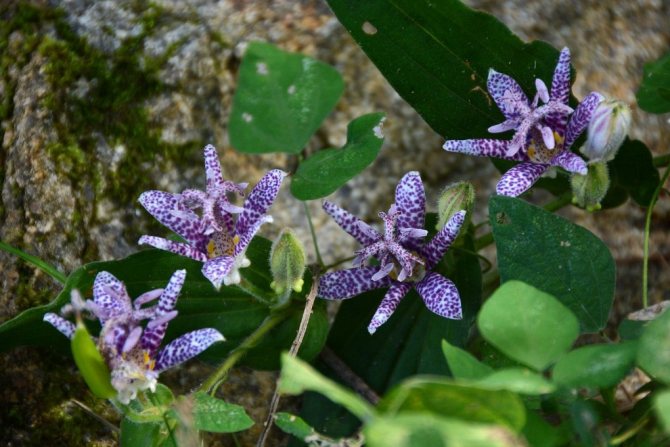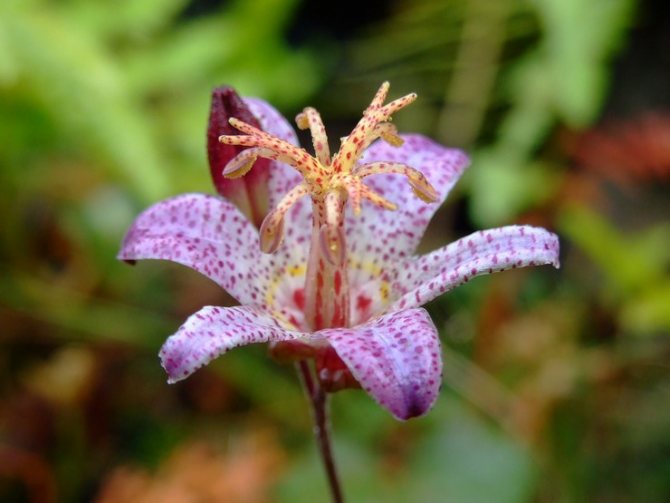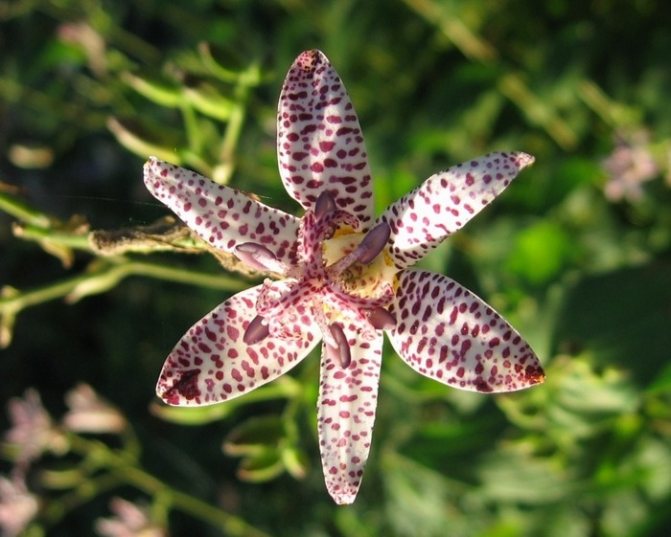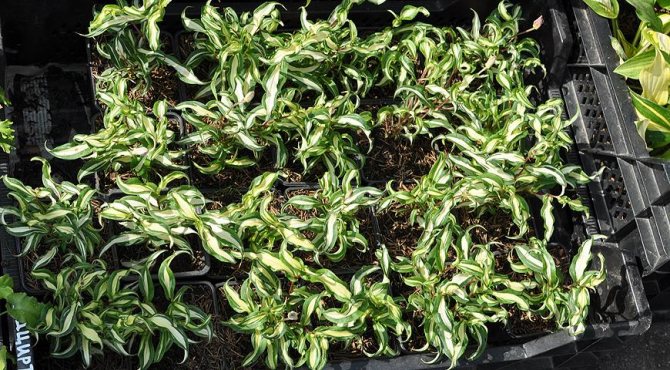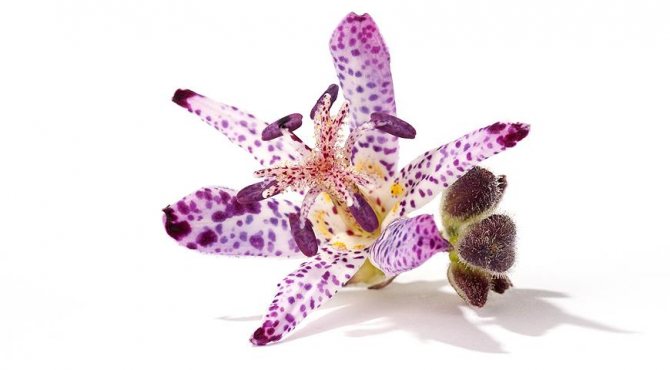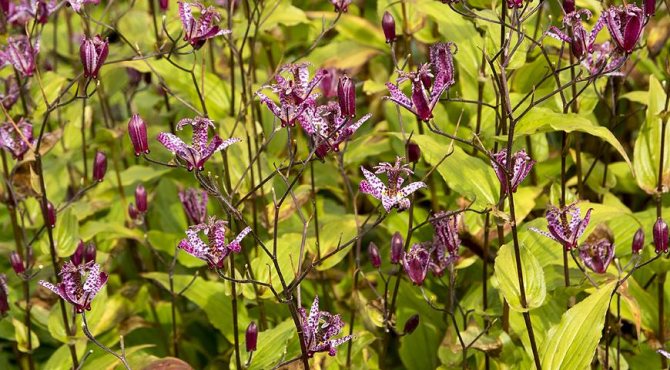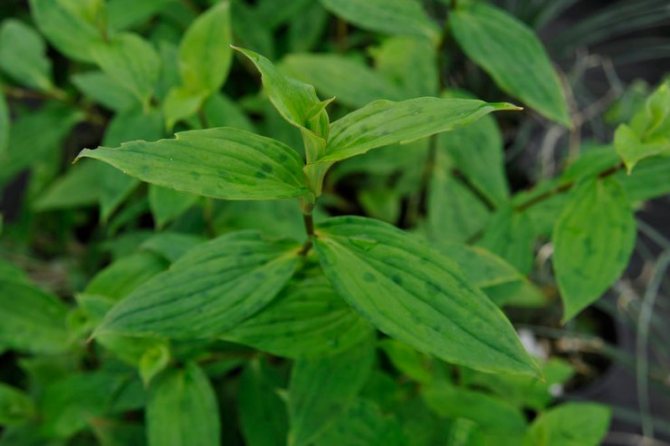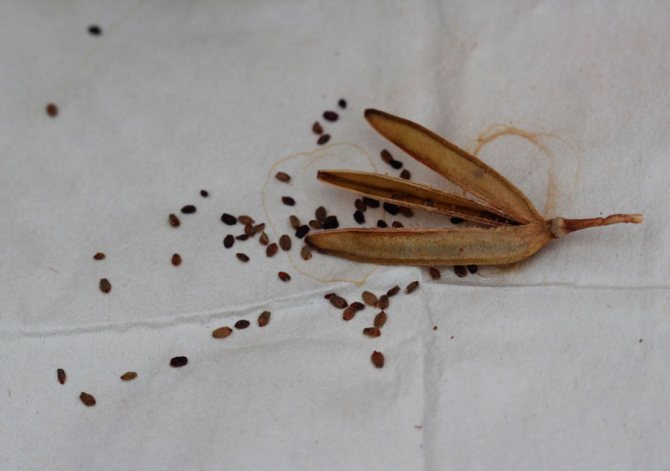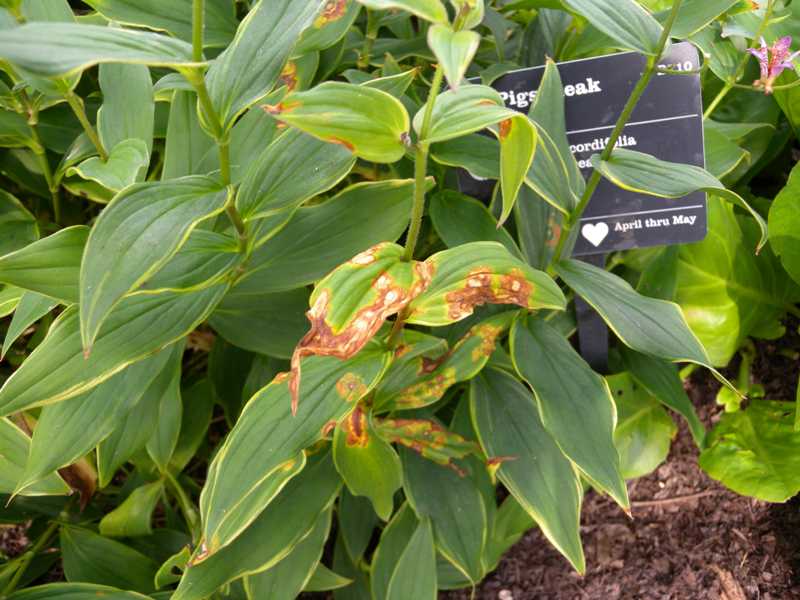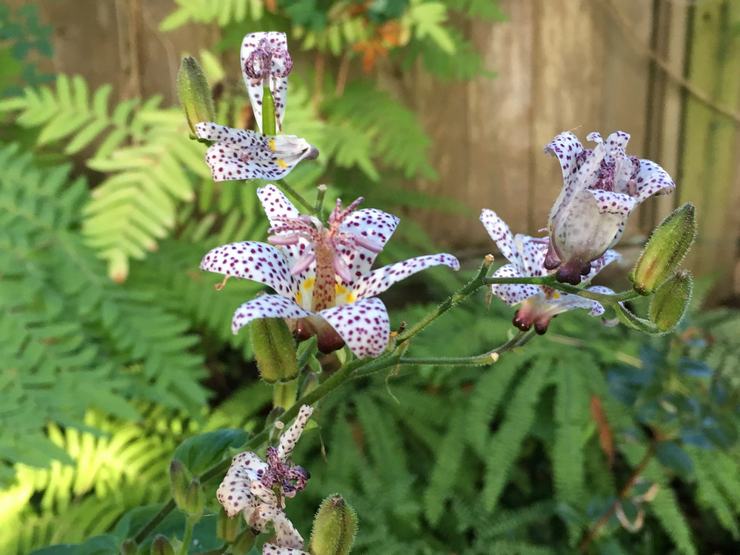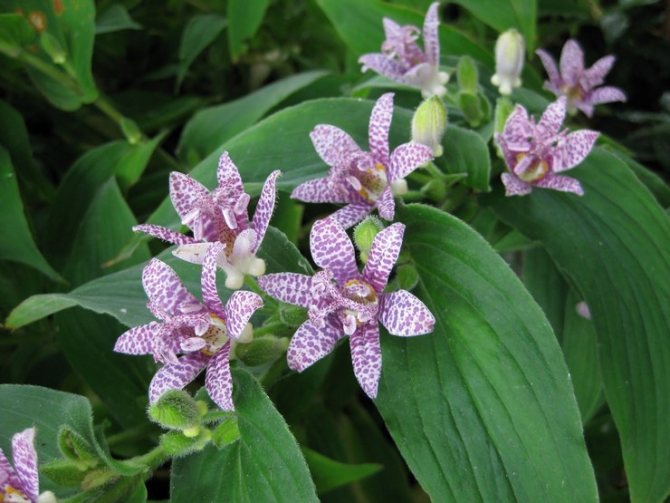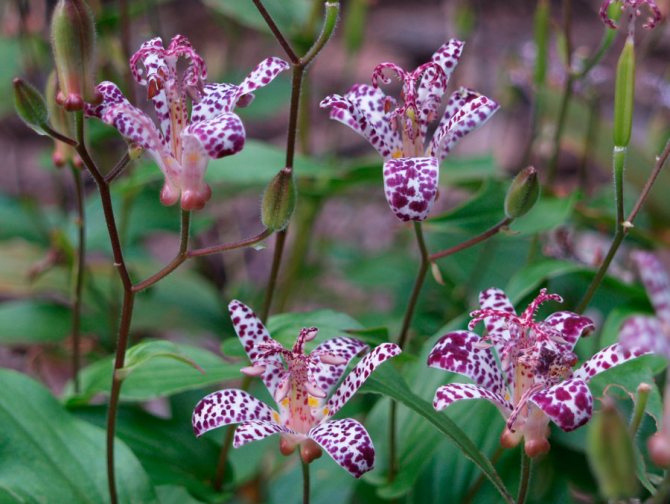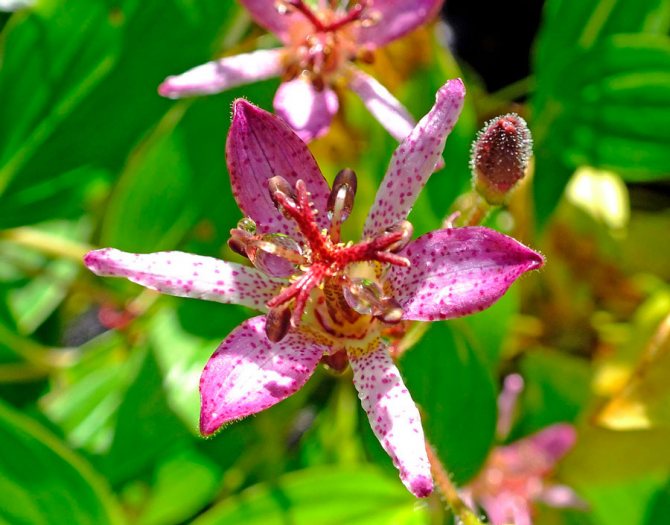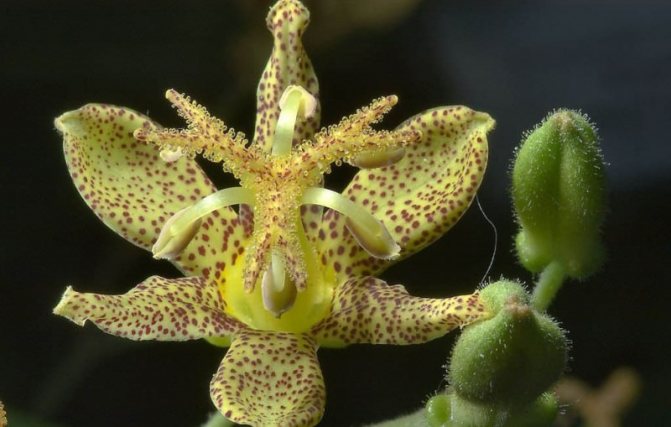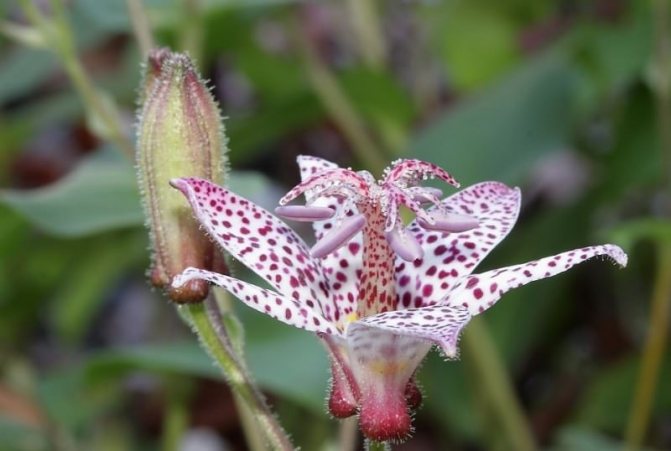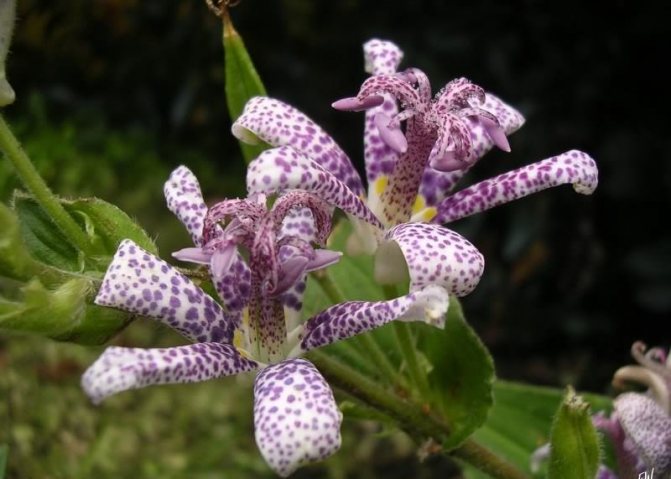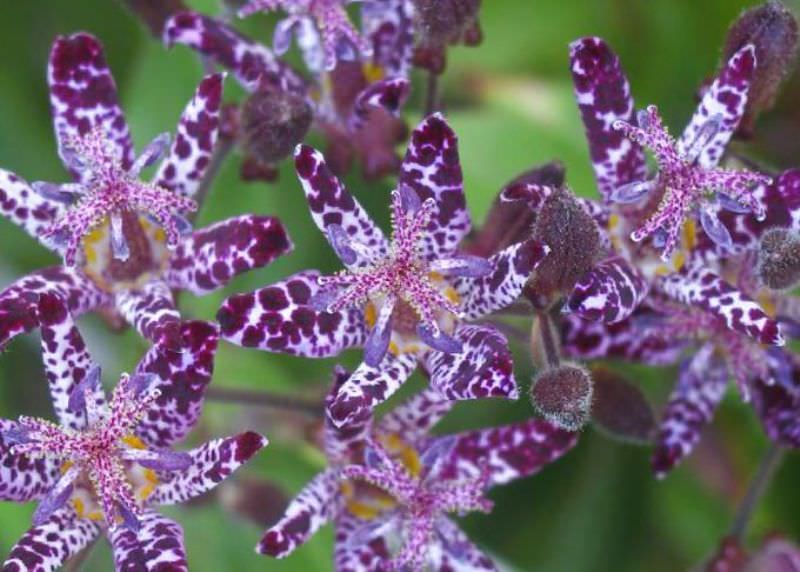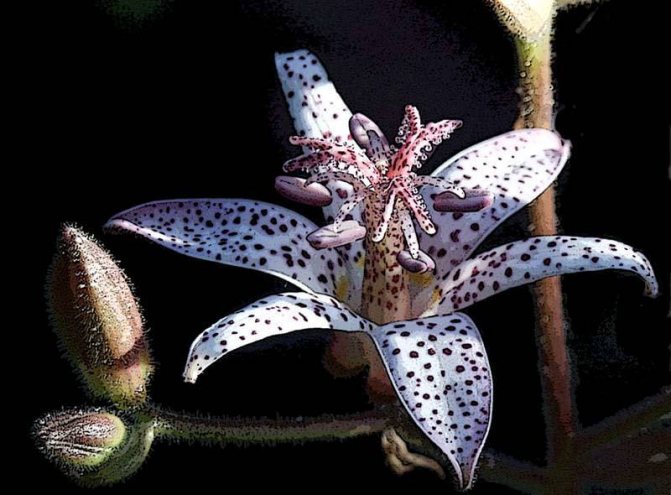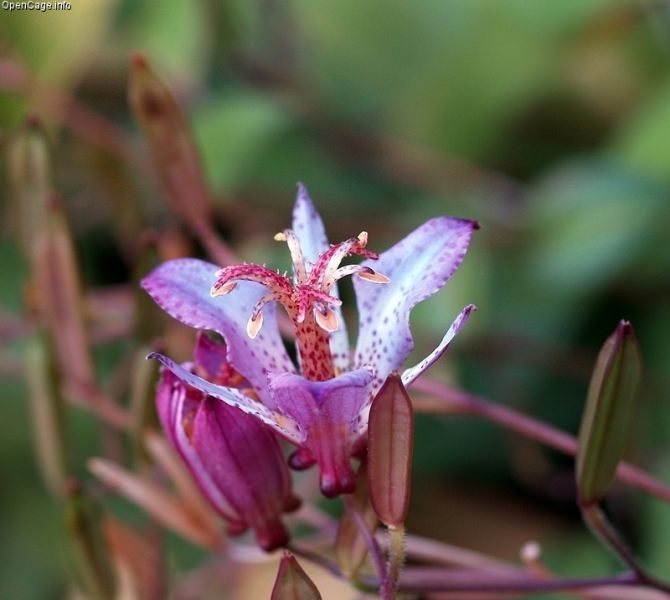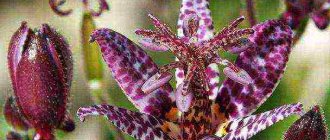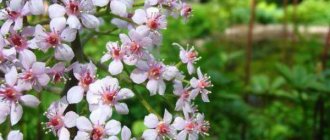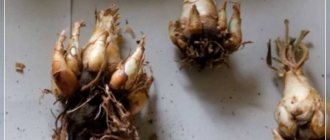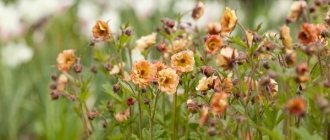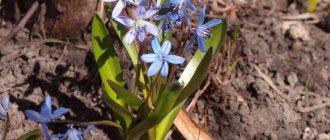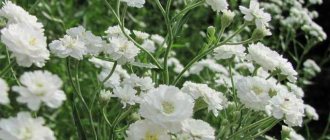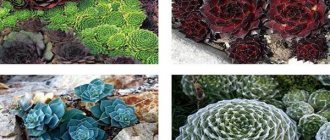Tricyrtis (Tricyrtis) is classified by botanists as a genus of herbaceous plants with beautiful flowers, it is included in the Liliaceae family. The native habitat of these flora representatives is in the Japanese territory and the Himalayas, as well as the eastern regions of Asia and the Far East, this also includes the Philippines and the lands of China. Among the species of the genus (which, according to the information provided in 2013 by The Plant List database, has approximately 20–23 units), there are such tricyrtis that are actively used in ornamental gardening. The plant prefers to settle in forests, where tree crowns provide partial shade, and the fallen deciduous mass saturates the soil with humus.
| Family name | Liliaceae |
| Growing period | Perennial |
| Vegetation form | Herbaceous |
| Breeds | By seeds or vegetatively (by dividing an overgrown bush, rooting of basal or stem cuttings) |
| Open ground transplant terms | In the spring |
| Landing rules | At a distance of 20 cm from each other |
| Priming | Light, but nutritious, not dry, black soil is better |
| Soil acidity values, pH | 6.5-7 (neutral ground) |
| Illumination level | Semi-shaded location or even full shadow |
| Humidity level | Despite the drought resistance, regular watering is recommended, in dry times, abundant, but neat |
| Special care rules | Fertilizers and watering are recommended |
| Height options | 0.5 m and more |
| Flowering period | June to September |
| Type of inflorescences or flowers | Single flowers or semi-umbellate, bundle-shaped or racemose inflorescences |
| Color of flowers | Snow white, yellow, cream, pink, solid or spotted |
| Fruit type | Seed capsule |
| The timing of fruit ripening | From early summer to September |
| Decorative period | Summer-autumn |
| Application in landscape design | Planting in flower beds and flower beds, as a container culture |
| USDA zone | 5–8 |
The name tricirtis was given due to the outlines of nectaries and the translation from Greek of the phrase "tria chtypimata" is perceived as "three tubercles". It is clear that later there was a transformation to the Latin "tricyrtis". Because of its similarity of flowers to the most real orchids, the plant is often popularly called "garden orchid", in Japanese lands you can hear the nickname "cuckoo" because the flower petals have beautiful spots, similar in color to the plumage of a bird. In the Philippines, the flower is called "toad lily", as it is used by locals when catching frogs.
All tricyrtis are perennials, but in our conditions not all species can withstand winters and therefore they are grown in tubs, carried out into the garden in the warm season, but most of them will require careful shelter. Therefore, usually the types of "garden orchids" are divided into frost-resistant and thermophilic. The root system of the "cuckoo" plant is quite well developed and is not located very deep in the soil, while it is characterized by the ability to regenerate when injured or frostbite. The stems are generally straight or possibly ascending, and sometimes branched from the middle to the apex.
In height, tricyrtis stems can reach an average of 50 cm, but often exceed this value (somewhere 70–80 cm). However, there are varieties in the genus with lower heights. In cross section, the stems are cylindrical.The color of the stems is green or with a reddish tint. Their surface is covered with pubescence of small fine hairs, which are also visible at the base of the foliage.
The stems of tricyrtis are covered with leaves, which are located on them in the next sequence. The outlines of the leaf blades can be both oval and lanceolate-oval, they are devoid of petioles or grow stalk-enveloping. Longitudinal venation is present on the surface. The foliage is painted in a rich green or dark green color scheme, but their upper side is decorated with not too noticeable mottling.
During flowering, which in the "toad lily" falls on the period from about the beginning of summer to September, the flower-bearing stem is pulled out. At the apex of the peduncles in tricyrtis or in the deciduous axils, single flowers form, but they can also gather in a racemose, semi-umbellate or bundle-shaped inflorescence. Moreover, the flowers are bisexual. The perianth is bell-shaped or tubular with six free petals, grouped in two turns: the outer rim has sacs that secrete nectar, and the inner rim has vertical leaves with ridges on the back. In length, the flowers reach about 4 cm or sometimes a little more.
The petals of the tricyrtis flower are painted in snow-white, yellow, cream, pink and various other tones, while the color can be monochromatic, graduated (gradually lightening from the top of the petal to the base) and decorated with purple or crimson spots contrasting with the general background. Six toad lily stamens grow from the base of the petals, their filaments slightly flattened to form a short tube. The anthers are attached with the back to the threads. Tricyrtis on the outer tepals can be characterized by the presence of sacs or a short spur, which is a nectary. But not all plant species can boast of this.
After pollination has passed, the "garden orchid" begins to ripen the fruits, with three corners representing wide-cylindrical capsules, when ripe, many small, flat, ovoid or round seeds are released from them.
The plant is not too difficult to care for and, with little effort, will decorate any corner of the garden.
Description of tricirtis
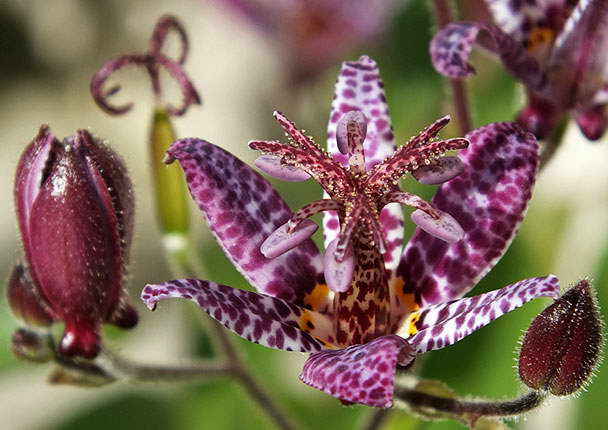
Garden orchid tricirtis planting and care in the open field photo
Tricirtis is a perennial ornamental plant from the numerous Liliaceae family. In nature, it is found in East Asia and the Far East, loves moist semi-shady forests and soils saturated with humus.
- The flower has a well-developed, shallow root system capable of recovery.
- The upright, thin stem is covered with leaves. The stem height is 60-100 cm, maybe even higher.
- The foliage is belt-shaped, oval or oval, has no petioles.
- The flowers are rather large, funnel-shaped, arranged singly or in bunches, half-umbels at the top of the stem.
- The color of the flowers can be cream, white, solid or spotted.
- Some species have a nectary - a small spur on the outer tepals.
- After flowering, the fruit appears - an elongated box with brown or black seeds.
Pests and diseases
Excessive moisture is the cause of the development of fungal infections, decay of the root system. This also leads to the appearance of slugs, which can eat leaves, damage the succulent parts of plants. In this regard, it is not recommended to overmoisten the soil, loosen it in a timely manner so that the roots are enriched with oxygen.
The soil near tricyrtis plants should be periodically inspected for pests. You can scatter granules of the Groza preparation. Gardeners recommend doing the so-called beer traps, filling small containers with dark beer. Uninvited guests will accumulate in them, which are removed mechanically. The procedure is repeated every month.
Garden orchids can be threatened by wood lice, which leave small holes in them. Tiny jumping insects 1-2 mm. (podura) are an indicator of excess moisture. Damage to young roots. The drug Aktara has a diverse spectrum of action. It is effective against scale insects, scale insects, thrips.
Choosing a landing site
Decide on the type of flower and find a suitable place for it. Planting and subsequent care will not be difficult, but certain features must be taken into account.
- The plant will feel comfortable in loose fertile soil, black soil is ideal.
- The landing site must be protected from drafts.
- Avoid stagnant water, but the roots should not be overdried.
- Tricirtis should receive good lighting for half a day, no matter what half of the day it will be: first or second.
Care rules
Taking care of a garden orchid is no more difficult than any flower bed plant.
Care involves the timely loosening of the soil, moderate watering and feeding, removing weeds, pruning dried flower stalks.
Watering and feeding
A properly selected area for growing tricyrtis already frees you from many problems in the process of caring for the plant.
Perennial is hygrophilous, but it will withstand a short dry period without moisture.
Water the plant under the root with cold, settled water.
From falling drops on the leaf blades, brown spots are formed in the places of exposure.
To retain moisture, you can mulch the soil around the root collar with organic debris or humus in the spring.
When growing tricyrtis on fertile soil, they do well without top dressing.
The plant responds to fertilizers with gratitude, reacts with active growth to both organic matter and mineral complexes, it does not like only unripe manure.
In early spring, plantings are fed with fertilizers containing nitrogen, and on the eve of flowering - with a solution of potassium-phosphorus preparations.
How to keep a garden orchid in winter
Preparation for wintering of frost-resistant varieties consists in covering the plantings with a thick layer of peat, spruce branches, fallen leaves or agrofibre.
Some flower growers build mini-sheds made of polyethylene over the plants to protect them not only from frost, but also from freezing after thaws.
The rhizomes of perennials that cannot withstand the winter cold are dug up for the winter and stored in a cellar in wooden containers with sawdust or peat.
Given the weak root system of tricyrtis, plants are often moved into a container along with an earthen clod.
Many growers grow perennials as a tub plant.
Growing tricyrtis and caring for it
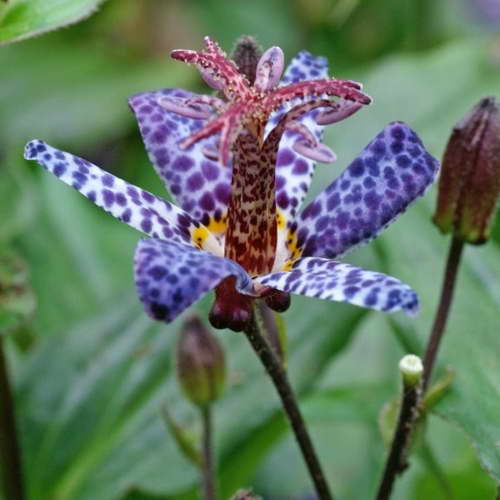

Tricyrtis blue wonder tricyrtis blue wonder planting and care photos
This luxurious plant loves loose, forest soils, enriched with peat and leafy humus. Tricirtis is drought-resistant, but the soil should always be moist, especially watch this in dry and hot weather.
Top dressing
In the spring, top dressing is carried out with compost or humus. Then you need to mulch the soil with pine bark so that the moisture does not evaporate much and the soil does not overheat. Tricyrtis prefer partial shade. It will be especially good for them in the tree-trunk circles - the soil is rich in plant residues, the foliage falling from the trees will protect in the winter cold. Only late-flowering varieties are planted in well-lit areas - this will help buds to set before the first frost.
Watering
You need to water tricirtis with warm water, using the best drip irrigation system. To prevent roots from rotting, avoid stagnant water.
Wintering
A flower can spend the winter in a flower bed, just cover it with special materials - peat or agrofibre.Young shoots do not tolerate overheating, therefore, with the arrival of the first heat in early spring, you should get rid of insulation. Then carry out the spring procedures described above (feeding, mulching) and in July-August you can enjoy the wonderful flowering.
Garden Orchid (video)
Moreover, leaves fallen from trees will reliably protect the roots of tricyrtis from the cold.
However, late flowering varieties are best placed in open areas. This is necessary so that they have time to form buds.
Good neighbors for tricyrtis are:
- ferns
- lilies
- hosts
- erythroniums
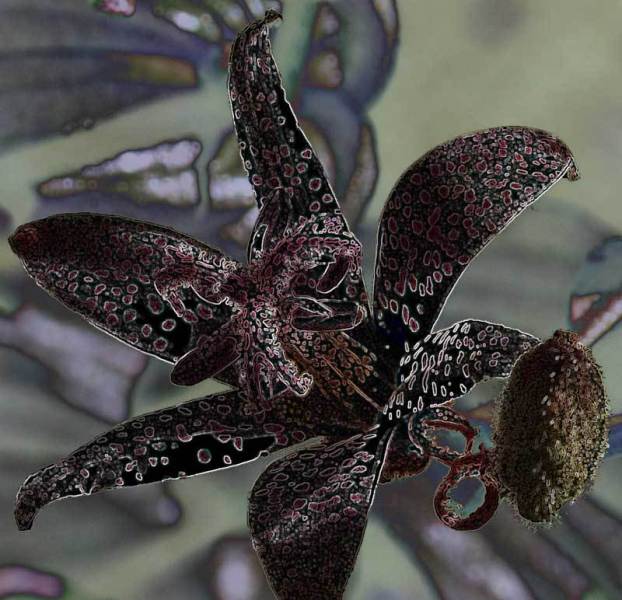

The presented plants require the same conditions as garden orchids. Tricyrtis look great in semi-wild gardens or in curbs.
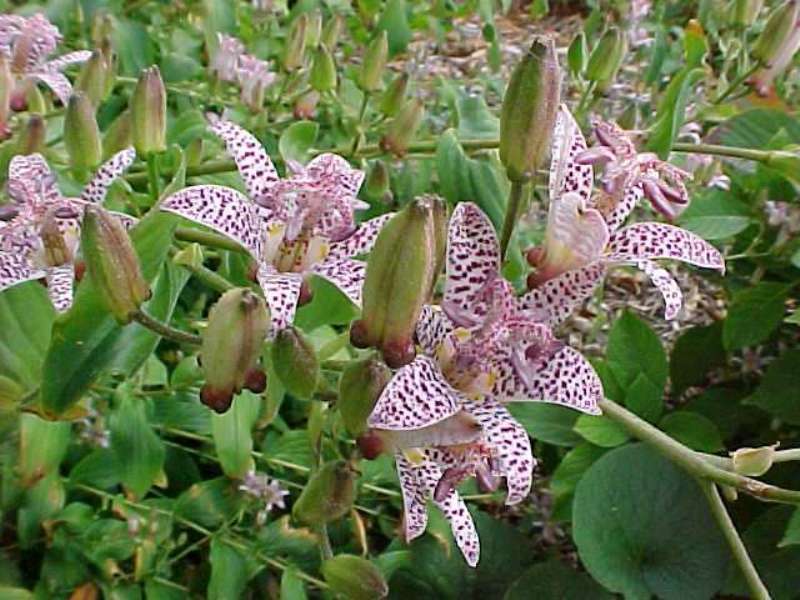

Growing tricyrtis from seeds
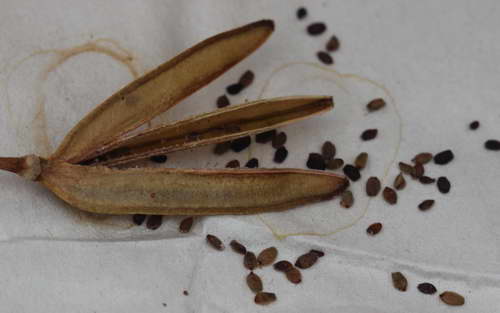

Seeds of tricirtis photo
Sowing seeds in the ground
Usually, seeds are sown in late autumn directly into open ground. These tricyrtis will start blooming next year. They are sown in late autumn, when the temperature drops, or in early spring, as soon as the snow melts and the soil is ripe. Seeds are not afraid of frost, and exposure to low temperatures will only improve germination.
Sow shallow, trying to sprinkle seeds as little as possible, as diving is not the most successful procedure. There should be a distance of 10-15 cm between the plants. The grown bushes can be planted separately, keeping a distance of 25-30 cm.
Growing seedlings at home
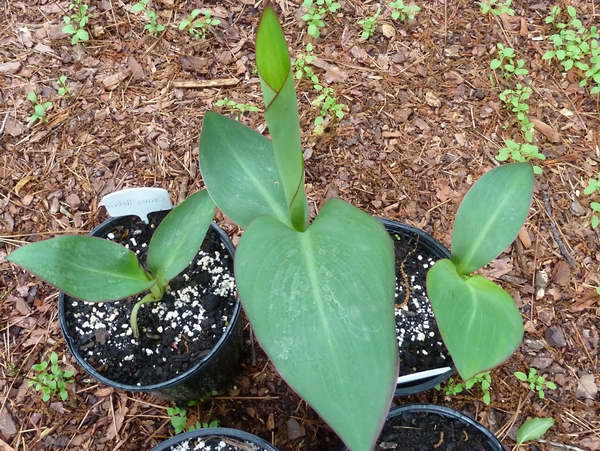

Seedlings of tricyrtis photo
Growing seedlings is possible.
- Around the beginning of February, pre-soak the seeds in a growth stimulator, pickle pink potassium permanganate for diseases (no more than 15 minutes, be sure to rinse).
- Lay in a universal substrate, deepening 1 cm into the soil, it is better to use peat cups.
- Put them in a warm, bright place, keep the temperature no higher than 15 ° C. When three leaves appear on the seedlings, feed with a weak solution of nitrogen-containing fertilizer. You can plant it in the ground when the threat of frost has passed. If you are worried about the death of the seedlings, you can cover them with plastic bottles cut in half.
Planting tricyrtis in the open field
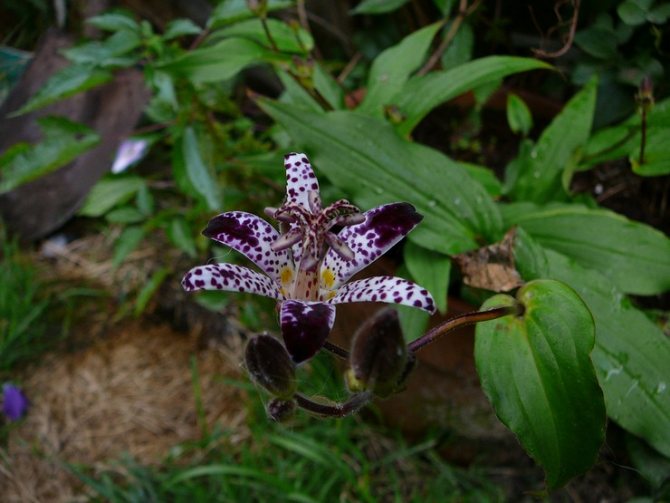

When to plant tricirtis
For sowing, freshly harvested seeds are used. The optimal time for planting tricyrtis in the ground falls in autumn. Before proceeding with spring sowing, you will have to stratify the seed material. The process of winter stratification is carried out in wooden boxes, which are stored in a cold dark place for 1.5-2 months.
More experienced gardeners have learned how to propagate perennials by a vegetative method, which also does not cause difficulties if you follow the instructions and planting rules.
How to plant tricirtis
Tricyrtis grow well in areas hidden in the shade cast by the crown of garden trees. The soil should be fertile with an admixture of peat, humus and forest land. Chernozems will provide the flower with the necessary amount of nutrients and create optimal conditions for the growth of perennials.
The location of the future flower bed should be protected and hidden from the slightest drafts.
The plant does not like excess moisture and cold wind. Tricyrtis cultivars, in which flowering occurs with a delay, require light. For this reason, it is better to avoid corners in the garden where autumn twilight sets in faster, since the buds will not be able to fully form.
Planting depth of tricyrtis seeds - no more than 3 mm. The sown area needs watering. Flowering is observed only in biennial or three-year-old seedlings.
Reproduction of tricyrtis by dividing the bush and root cuttings
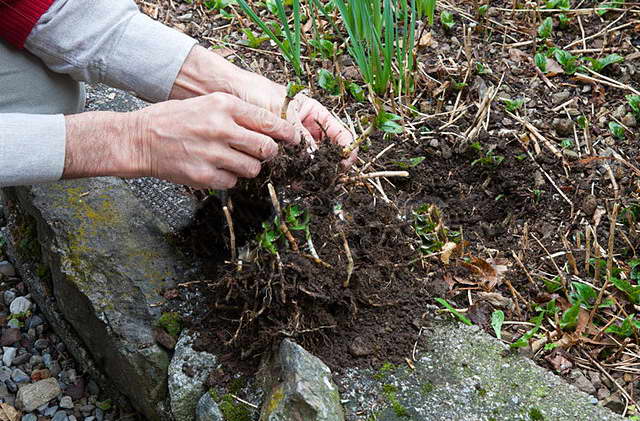

How to divide a tricirtis bush photo
It has been experimentally proven that it is more reliable to propagate tricyrtis vegetatively - by dividing the bush and root cuttings in the spring, in the summer they use stem cuttings. It's enough to dig them in and wait for the development of a new plant. Even the smallest remnants of roots in the soil are capable of giving new shoots.
Breeding options
There are three ways to propagate tricirtis:
- seeds
- division of rhizomes
- vegetatively
The latter method is preferred. At the same time, you do not need to dig out the plant, you just need to dig a tunnel and separate part of the bush.
If it is not possible to divide tricyrtis, you can try seed propagation. But the process will be longer and more complicated. Seeds are sown directly into the ground to a depth of 5 cm.
Before sowing, the planting material is soaked in a special solution - a growth stimulator. When planting them for seedlings, stratification is carried out.
A universal substrate acts as a soil. Planting depth is 3-5 cm. The optimum growing temperature is 15 ° C. Plants will bloom in about the second year after planting.
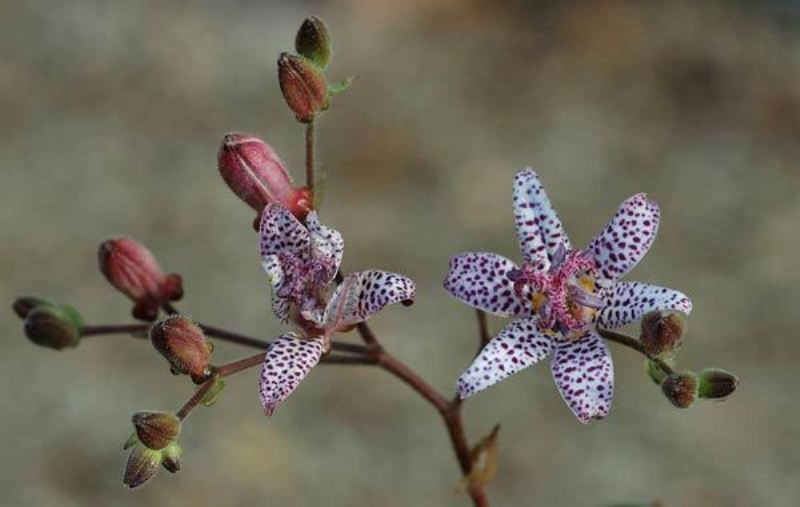

It is possible to propagate tricyrtis by rhizomes in spring or autumn, since it is at this time that the plant is at rest. In this case, it is important to ensure that at least 2 kidneys remain on each fragment. After you have separated the rhizomes, they can be immediately placed in the soil, previously moistened and dug up.
Types of tricyrtis with photos and descriptions
The types of tricyrtis do not have any special differences in appearance. A related group consists of hairy tricyrtis, stolonose tricyrtis, short-haired tricyrtis, beautiful tricyrtis, long-legged tricyrtis. In these species, the leaves are oval-lanceolate, the flowers are pale pink with crimson spots. Flowers are collected in bunches in the axils of the leaves. They bloom beautifully in autumn, but cannot stand cold winters.
The slightly pubescent and broad-leaved species are even more similar. In spring they are covered with variegated oval leaves and bunches of yellow flowers.
Tricyrtis short-haired Tricyrtis hirta
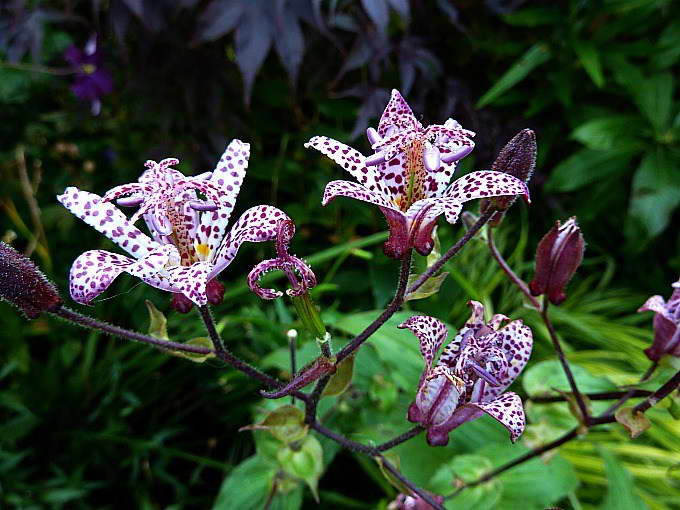

Tricyrtis short-haired Tricyrtis hirta photo
Most often grown. The stem reaches a height of 80 cm, wide oval leaves are slightly pubescent, 15 cm long and 5 cm wide. This species grows very quickly due to underground horizontal shoots.
Tricyrtis formosana tricyrtis formosana
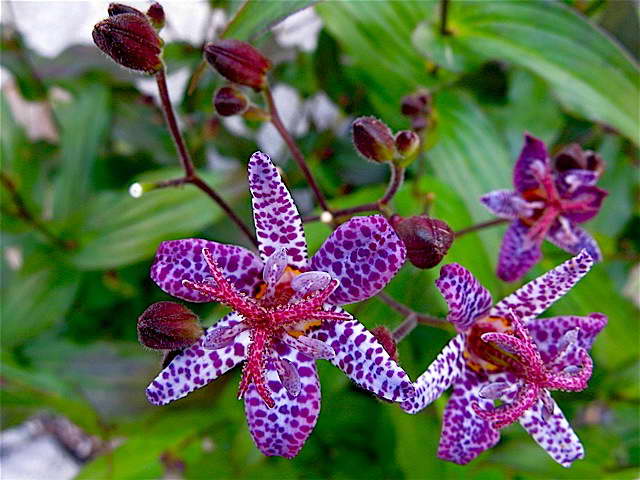

Tricyrtis formosana tricyrtis formosana photo
Summer residents and gardeners are very fond of this species, although it is still quite rare. The most popular variety is Purple Beauty. This short tricyrtis has leathery leaves and rare flowers. Half-grown white petals are covered with purple spots. The lower part of the fused petals is surrounded by a yellow circle, the middle of the flower is also yellow.
Winter hardy species
There are many types of tricyrtis, but most of them cannot withstand even slight frosts, except for two species.
Tricirtis short-haired (already mentioned above) - a native of Japan, most staunchly tolerates wintering in the ground. The bush reaches over a meter in length, oval leaves are broadly lanceolate, marked, more than 15 cm in length. The flowers are white-pink with purple spots.
Tricyrtis broadleaf Tricyrtis latifolia
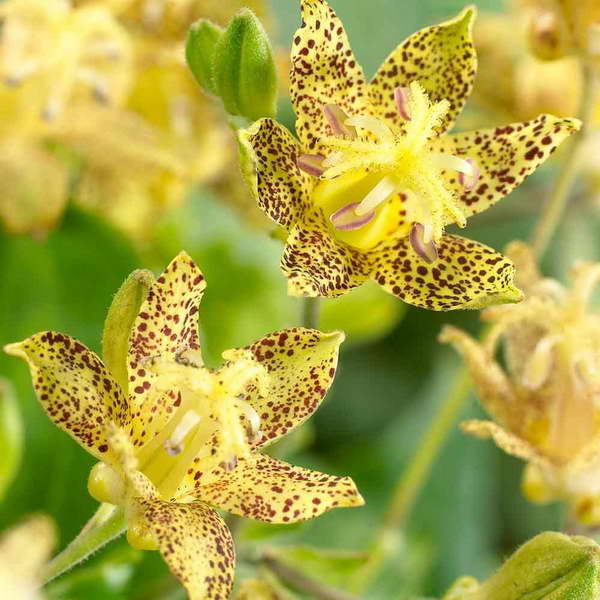

Tricirtis broadleaf yellow sunrise photo
Originally from China. It grows up to 60 cm in height, has oblong, spotted leaves. Flowers are white-green, covered with spots, located at the top of the stem and gather in a bunch.
Tricirtis is a flowering herbaceous perennial plant from the numerous Liliaceae family, of which there are about 20 species. Most of them grow wild, and some are grown as horticultural crops. These exquisite flowers resemble orchids, but they are much more unpretentious in care.
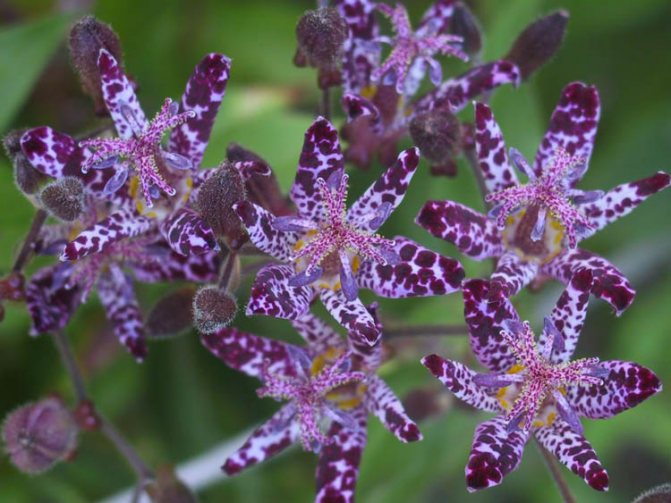

In Greek, the word tricirtis is read as “three tubercles” - it got its name due to the fact that this flower has three nectaries. The plant is native to eastern countries, most often found in the Himalayas and Japan. As garden flowers, tricyrtis have been grown since the 9th century, but they gained great popularity only in the 20th century.

